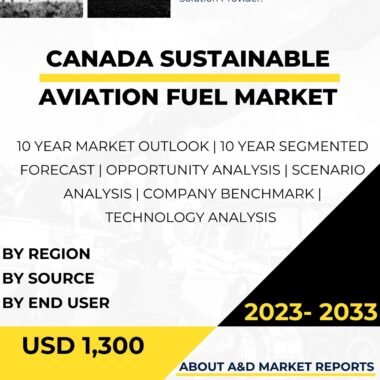Description
Australia Sustainable Aviation Fuel (SAF) Market Overview
The Sustainable Aviation Fuel Market has seen strong growth, driven by the country’s efforts to reduce greenhouse gas emissions and promote sustainability in aviation. Sustainable aviation fuel—also called biojet fuel or drop-in fuel—is made from renewable sources such as biomass, agricultural waste, and used cooking oil. As Australia aligns with international climate goals, adopting SAF has become essential for reducing aviation’s carbon footprint and achieving long-term environmental targets.
Sustainable Aviation Fuel Market of Decarbonization Driving Market Growth
A key factor behind the growth of the Australia sustainable aviation fuel market is the global movement toward decarbonization and a low-carbon economy. Aviation remains a major source of greenhouse gas emissions, and SAF offers a practical way to reduce aviation’s carbon intensity. Using SAF helps airlines transition toward cleaner, more sustainable operations without compromising performance.
Sustainable Aviation Fuel Market of Strategic Partnerships and Collaborations
Strategic partnerships have strengthened the Australia sustainable aviation fuel market. The country works closely with international stakeholders, fuel producers, and research organizations to accelerate SAF development. These collaborations support knowledge-sharing, technology exchange, and investment in production facilities, ensuring Australia’s leadership in sustainable aviation initiatives.
Diversifying Aviation Energy Sources
The need to diversify aviation’s energy mix has been another driver for SAF adoption in Australia. Conventional jet fuels derived from fossil resources emit large amounts of carbon dioxide. By integrating SAF into their operations, airlines can reduce their emissions while maintaining energy reliability. This transition also supports Australia’s broader energy diversification goals.
Supporting National Climate Commitments
Australia’s pledge to meet emission reduction targets under the Paris Agreement has further increased the demand for sustainable aviation fuel. The aviation industry is under growing pressure to contribute to national climate goals, and SAF adoption provides a clear path toward carbon neutrality and long-term sustainability.
Technological Advancements in SAF Production
Innovation in feedstocks and production processes has transformed the Australia sustainable aviation fuel market. Modern technologies such as hydrotreatment and hydrothermal liquefaction have improved the efficiency and cost-effectiveness of SAF. These processes produce high-quality fuels with similar performance to conventional jet fuel, making adoption easier for airlines.
Indigenous Development and Local Innovation
Indigenous research and development play a vital role in the Australia sustainable aviation fuel market. Domestic companies and research institutions invest heavily in SAF projects tailored to local feedstocks and conditions. This focus strengthens the domestic bioenergy sector, creates jobs, and supports regional economic development.
Environmental Sustainability and Corporate Responsibility
Airlines and aviation companies are increasingly adopting SAF to meet sustainability goals and investor expectations. The use of SAF helps them reduce emissions and demonstrate corporate responsibility. This commitment enhances brand reputation and aligns with growing consumer demand for eco-conscious travel options.
Enhancing Energy Security and Reducing Imports
Producing SAF from domestic renewable sources improves Australia’s energy security and reduces dependence on imported fossil fuels. Local SAF production shields the aviation sector from fuel price volatility and supports regional economies through new supply chains and employment opportunities.
Broader Industrial and Civilian Applications
Beyond aviation, sustainable aviation fuel is finding applications in shipping, transportation, and power generation. Its compatibility with existing infrastructure makes SAF a cost-effective and sustainable substitute for fossil fuels across multiple sectors.
Strategic Importance in the Indo-Pacific
Australia’s location in the Indo-Pacific, with heavy air traffic and strong regional connections, highlights the strategic need for SAF adoption. Widespread SAF use could reduce regional emissions and promote cleaner aviation practices across Asia-Pacific.
Future Outlook
The Australia sustainable aviation fuel market is expected to remain dynamic and competitive, driven by innovation, investment, and environmental policy. Continued advancements in technology and local production will ensure Australia’s leadership in sustainable aviation. The strategic deployment of SAF strengthens national energy resilience, supports climate objectives, and demonstrates Australia’s commitment to a cleaner, greener aviation future.




